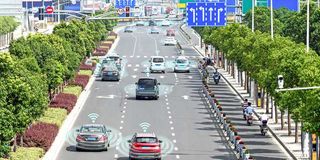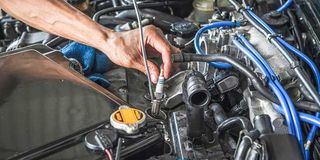
The current transition from manual to digital is not much fun.
Computerisation has made a lot of life tasks much more convenient. So why do I seem to be spending so much more time and stressing over perplexing website designs while doing personal admin? Pre Gen Z.
The progressive “computerisation” of life’s red tape is generally welcome. Turning everything from mountains of paper forms and files into e-systems—physical visits, queuing, and deliveries at the touch of a button while sitting in your chair, should eventually make all our personal administration tasks simpler, clearer and very much quicker. And, in theory, less corruptible.
However, the current transition from manual to digital is not much fun. The source manual records were profoundly incomplete and corrupted-- riddled with errors and omissions — and, as old ink is converted into binary bytes, computers can spot hitherto undetectable anomalies in a split second. But they can’t “fix” them. They just automatically “reject” the process and raise a red flag.
Far from speeding up an administrative process, this can bring it to a complete halt. And trigger a manual investigation to sort out each problem. Perhaps millions of them. Also, the keying in of even correct information is not error-proof and website design has room for improvement.
The red flag
Because computers can now cross-refer between one piece of red tape and another, and officials have seized upon this new capacity and added a whole raft of new regulations, a quirk on one permit, licence, certificate renewal or service can cascade to others. A red flag doesn’t stop just one process. It can stop your life!
The misreading of a hand-scrawled Z, so it reads 2 on a digital reference number, can prevent renewal of a driving licence, registration of a vehicle, or licence to run a company, or application for a permit, upon which other basic entitlements and daily functions might depend.

Computerisation has made a lot of life tasks much more convenient.
And even if all your references are precisely correct, the computers might instantly reveal that several other people have the same vehicle registration number as you. Red Flag. Stop the process.
Even if your position is completely honest, kosher, and compliant, proof of that can take forever (or for-never) to establish and confirm, and, meanwhile, you are uninspected, uninsured and unlicensed, so a vehicle vital to your business is off the road, or whatever.
Sorting out these snafus might be a booming business for Internet servers, cybercafés, accountants, lawyers and registrar services, but it comes at an enormous cost to individuals and small businesses in stress, loss of productivity, direct expense and, above all, time.
Right now, complying with all red tape regulations and administration can take an individual more time than all public holidays and days off put together. And even after devoting all that precious resource, clear passage and peace of mind are by no means guaranteed.
Clever programmers
Conversion of entire national databases on this scale is bound to have teething problems and learning curves. But surely it does not reverse the first principle of justice: the presumption of innocence. And cannot all those clever computer programmers, policymakers, accountants, lawyers, registrars and officials devise a system that allows life and civil liberties to go on while anomalies are checked and resolved?
Or, as is globally common during issues of such momentous change, start with an amnesty. The conversion task itself is difficult enough, without using it as an archaeological dig for rent-seeking and revenue-generating opportunities. Its purpose and value is tomorrow, not yesterday.
Let’s go digital as quickly and comprehensively as possible, get all processes processed with electronic speed, and move forward with a whole new level of clarity, efficiency and accuracy.

Computerisation is already a well-advanced component of trucking all over the world.
Meanwhile, citizens should not automatically be blamed or punished, even temporarily, for systemic anomalies. The onus is on the system, not just the citizen, to get things right…in a user-friendly way from the first click to a big green tick. Also, national system websites need to recognise that there is a teeny-weeny little computer system called Apple. There are about 200 million people in the world who use it.
Use gears to avoid cooking the brakes

Minibus brakes are efficient under normal conditions and are quite capable of an abrupt emergency stop.
Why do matatus, which like to go as fast as possible, sometimes go quite slowly down hills where they could go fastest?
Matatu drivers rarely pass up an opportunity to travel at their maximum legal speed of 80kph. Or more. They are certainly not inhibited by passenger comfort, safety, or good manners. If their speed is restrained it is because, physically, they can’t go any faster. Like up a steep hill.
But in some locations – downhill, on a straight, wide and smooth road and where traffic rarely clogs up – they have been “backing off” for several years. To 70, or 60 or even less…for a distance of several kilometres on a stretch where a higher speed would be easy to achieve and where there is no particular hazard. A prime example is the long and fairly steep final descent on the “top road” heading towards Lake Naivasha. So what’s going on?
Having owned a minibus for several years as a “family car”, and sometimes driven one with a full load at high speeds (nearly double their limit) on safari rally service duty, here’s my theory: down long and steep hills, they can easily do 100 or more, or they can do 60 or less; but they simply cannot do 80! Because at that speed, and that speed only, in high gear they would cook their brakes.
Minibus brakes are efficient under normal conditions and are quite capable of an abrupt emergency stop. But if brakes are frequently and firmly applied, or applied even moderately for a sustained period without long intervals to let them cool off, they are especially prone to overheating and severe brake fade. And by severe I mean that when you press the middle pedal nothing happens.
So if, at the top of the hill, they engaged fourth or fifth gear, with no pressure on the accelerator the vehicle would gain speed downhill and soon exceed the limit. To stay at 80 they would have to “ride” the brakes almost constantly. Doing that firmly enough to hold the speed of a vehicle with an all-up weight of three tonnes on a steep descent would cause temporary - but almost total – brake failure. Even matatu drivers are unfond of that.
One option is to brake less and go faster, but on this stretch of the northern corridor safety experiment, radar traps (both real and imagined) are frequent and draconian. And there is always a police check at the bottom. The only alternative is to engage third gear so the downhill speed gain is reduced by engine resistance revs.
The natural result of that technique, with occasional moderate braking to prevent over-revving, is a speed of 60 to 70. Bingo. As the road levels out and the radar-trap zone is passed, it’s back to a higher gear and 80 kph. Or more. It does make you wonder whether the road safety experts who sit on the committees that design the policies that have so far failed to make the top road safe have ever driven a fully loaded minibus.
Does that experience have a seat at the policy table? Are gaps like that the reason safety policies are so often based on knee-jerk presumptions, instead of practical realities? In this instance, should the focus be on radar traps and speed bumps…or the temperature rating of brake linings?
The mantra on long and steep hills is that you should descend them in the same gear you would use to drive up them. With very heavy trucks, the “engine braking” principle is even more extreme and crucial. There are brake linings and fluids designed to remain effective even at phenomenally high temperatures. But they are expensive and have a downside: at normal motoring temperatures they are less efficient than standard linings. They are for rallies and racing cars. Judging by the brake smells at the bottom of steep hills (eg the Salama/Ulu escarpment) perhaps some other vehicles would benefit from them.
Tech tips: Losing spark and tyre expiry dates…
Do well-used spark plugs in apparently good condition need to be replaced and how often? MW

Spark plugs get old - even if they are kept clean and properly adjusted and the electrode is not excessively worn.
Spark plugs get old - even if they are kept clean and properly adjusted and the electrode is not excessively worn. The recommended lifespan is 15,000- 20,000 kms. Though they can still be made to look clean, and the gap can be correctly set, beyond that age the spark could be significantly less strong, causing less efficient combustion and hence higher fuel consumption and lower performance. Changing the plugs at this stage will save more money than it costs Each spark plug in a car engine fires hundreds of times per second when the engine is running - that means millions of times between one service and the next. The efficiency of the ceramic insulator and the shape and conductivity of the electrode deteriorate.
You say the rubber in tyre compounds has changed. Why, and for what benefit? Solomon.
Modern tyre casings are a cocktail of steel and fibres and fabric, and even the black squidgy part (“rubber”) is a mixture of more than a dozen different materials and synthetics, to make them grip better, last longer, resist perishing and...to help keep the air in. Natural rubber is not airtight. It “breathes”. That’s why, in years gone by, “topping up the tyre pressure” was a regular task almost every time the car was refueled. Natural rubber is also more prone to perishing, and can be degraded by some chemicals – like oil. Modern synthetic compounds retain the air much more efficiently and are less prone to chemical damage. In good circumstances there will be no loss of pressure for many thousands of kilometres.
Nevertheless, tyre pressures should be checked at quite regular intervals as pressure can still be lost through microscopic cracks or tiny valve defects, and the wrong pressure will reduce economy, comfort and safety. Severe under-inflation is not only expensive but downright dangerous! The tyre pressure recommended by your car’s manufacturer is not only the optimum pressure for a balance of control, comfort and economy; it is also the lowest pressure you should ever run on. The only time lower pressures can be beneficial is when driving through deep, soft sand.
In all other circumstances, the recommended pressure is the minimum. Always keep your tyre pressures at that level or slightly higher. There are circumstances when pressures should be considerably increased - when the car is fully laden, and/or when travelling at high speeds for long distances, and/or when driving fast on rough and stony road surfaces. For each of those conditions, add 10% to the pressure. When adjusting tyre pressures before or after journeys in such extreme conditions, make the adjustment when the tyres are cool. Hot tyres give “false” pressure readings.









